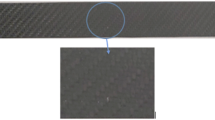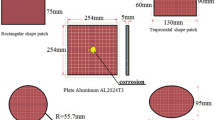Abstract
Since the implementation of the composite patch bonding repair technique, this process has gradually replaced traditional bolting or welding methods. The correct choice of fiber type for the composite patch guarantees better durability of the repair. Carbon fiber composites, favored for the most advanced aeronautical and industrial applications, have shown great effectiveness in reducing stress at the damaged area. They are chosen for their high strength, low weight and high stiffness compared to other fibers. This work is part of this context, as the objective is to highlight, through a numerical analysis by finite elements, the interest of applying patches based on carbon fiber to reduce the stress concentration at the level of a damaged plate (a plate with a side crack and another plate with a crack emanating from a notch). Two types of carbon fiber were chosen, high modulus fiber and high strength fiber. Composite patches were bonded using Adekit A-140 adhesive to repair a 2024-T3 aluminum plate. The plate and the adhesive were introduced as materials with elastoplastic behavior where the adhesive was taken as being a third material. However, for the composite an orthotropic material was considered by introducing the respective engineering constants. The objective is to highlight the benefit of using high modulus (HM) or high strength (HS) carbon fibers compared to other fibers. The effects of crack size, presence of a notch, applied stress and the use of a hybrid composite (combination of HM fibers and HS fibers) were taken into consideration. The results showed clearly that the carbon fiber patch absorbs clearly a large amount of stress from the damaged area and ensures good resistance of the repaired plate.


























Similar content being viewed by others
References
Pyles R (2003) Aging aircraft: USAF workload and material consumption life cycle patterns. Rand, Santa Monica
Baker AA (1984) Repair of cracked or defective metallic aircraft components with advanced fibre composites—an overview of Australian work. Compos Struct 2(2):153–181. https://doi.org/10.1016/0263-8223(84)90025-4
Baker AA, Rose LF, Jones R (eds) (2002) Advances in the bonded composite repair of metallic aircraft structure. Elsevier, Amsterdam. https://doi.org/10.1016/B978-008042699-0/50003-6
Baker A (2008) Structural health monitoring of a bonded composite patch repair on a fatigue-cracked F-111C wing. DEFENCE SCIENCE AND TECHNOLOGY ORGANISATION VICTORIA (AUSTRALIA) AIR VEHICLES DIV. Consulté le: 31 janvier 2022. [En ligne]. Disponible sur: https://apps.dtic.mil/sti/citations/ADA485406
Baker A, Rajic N, Davis C (2009) Towards a practical structural health monitoring technology for patched cracks in aircraft structure. Compos Part Appl Sci Manuf 40(9):1340–1352. https://doi.org/10.1016/j.compositesa.2008.09.015
Sun CT, Klug J, Arendt C (1996) Analysis of cracked aluminum plates repaired with bonded composite patches. AIAA J. 34(2):369–374. https://doi.org/10.2514/3.13073
Klug JC, Sun CT (1998) Large deflection effects of cracked aluminum plates repaired with bonded composite patches. Compos Struct 42(3):291–296. https://doi.org/10.1016/S0263-8223(98)00018-X
Gong XJ, Cheng P, Aivazzadeh S, Xiao X (2015) Design and optimization of bonded patch repairs of laminated composite structures. Compos Struct https://doi.org/10.1016/j.compstruct.2014.12.048
Ramji M, Srilakshmi R, Prakash MB (2013) Towards optimization of patch shape on the performance of bonded composite repair using FEM. Compos Part B Eng 45:710–720. https://doi.org/10.1016/j.compositesb.2012.07.049
Ayatollahi MR, Hashemi R (2007) Mixed mode fracture in an inclined center crack repaired by composite patching. Compos Struct 81(2):264–273. https://doi.org/10.1016/j.compstruct.2006.08.013
Madani K, Touzain S, Feaugas X, Cohendouz S, Ratwani M (2010) Experimental and numerical study of repair techniques for panels with geometrical discontinuities. Comput. Mater. Sci. 48(1):83–93. https://doi.org/10.1016/j.commatsci.2009.12.005
Xiong Y, Raizenne D (1996) Stress and failure analysis of bonded composite-to-metal joints. Paper presented at the 83rd Meeting of the AGARD SMP on bolted bonded joints in polymeric composites, Florence, Italy, 2–3 September 1996. AGARD conference proceedings 590. ISBN 92-836-1046-6
Breitzman TD, Iarve EV, Cook BM, Schoeppner GA, Lipton RP (2009) Optimization of a composite scarf repair patch under tensile loading. Compos Part Appl Sci Manuf 40(12):1921–1930. https://doi.org/10.1016/j.compositesa.2009.04.033
Madani K, Touzain S, Feaugas X, Benguediab M, Ratwani M (2008) Numerical analysis for the determination of the stress intensity factors and crack opening displacements in plates repaired with single and double composite patches. Comput. Mater. Sci. 42(3):385–393. https://doi.org/10.1016/j.commatsci.2007.08.010
Kaddouri N, Kouider M, Amine MB, Feaugas X (2019) Analysis of the presence of bonding defects on the fracture behavior of a damaged plate repaired by composite patch. Frat. Ed Integrità Strutt. 13(49):49. https://doi.org/10.3221/IGF-ESIS49.33
Kaddouri N, Madani K, Rezgani L, Mokhtari M, Feaugas X (2020) Analysis of the effect of modifying the thickness of a damaged and repaired plate by composite patch on the J-Integral; effect of bonding defects. J. Braz. Soc. Mech. Sci. Eng. 42(8):426. https://doi.org/10.1007/s40430-020-02515-y
Djebbar SC et al (2022) Substrate geometry effect on the strength of repaired plates: Combined XFEM and CZM approach. Int J Adhes Adhes. https://doi.org/10.1016/j.ijadhadh.2022.103252
Madani K, Djebbar SC, Kaddouri N, El Ajrami M, Belhouari M (2022) Use of combined CZM and XFEM techniques for the patch shape performance analysis on the behavior of a 2024-T3 aluminum structure reinforced with a composite patch. Frattura Ed Integrità Strutturale 16(62):304–325. https://doi.org/10.3221/IGF-ESIS.62.22
Madani K, Touzain S, Feaugas X, Benguediab M, Ratwani M (2009) Stress distribution in a 2024–T3 aluminum plate with a circular notch, repaired by a graphite/epoxy composite patch. Int. J. Adhes. Adhes. 29(3):225–233. https://doi.org/10.1016/j.ijadhadh.2008.05.004
Khan SM, Essaheb M (2017) Effect of patch thickness on the repair performance of bonded composite repair in cracked aluminum plate. Mater. Today Proc. 4(8):9020–9028. https://doi.org/10.1016/j.matpr.2017.07.255
Gong XJ, Cheng P, Aivazzadeh S, Xiao X (2015) Design and optimization of bonded patch repairs of laminated composite structures. Compos Struct 123:292–300. https://doi.org/10.1016/j.compstruct.2014.12.048
Mohammed SM, Mhamdia R, Albedah A, Bouiadjra BA, Bouiadjra BB, Benyahia F (2021) Fatigue crack growth in aluminum panels repaired with different shapes of single-sided composite patches. Int. J. Adhes. Adhes. 105:102781. https://doi.org/10.1016/j.ijadhadh.2020.102781
Turan K, Örçen G (2017) Failure analysis of adhesive-patch-repaired edge-notched composite plates. J. Adhes. 93(4):328–341. https://doi.org/10.1080/00218464.2015.1116984
Okafor AC, Bhogapurapu H (2006) Design and analysis of adhesively bonded thick composite patch repair of corrosion grind-out and cracks on 2024 T3 clad aluminum aging aircraft structures. Compos Struct 76(1):138–150. https://doi.org/10.1016/j.compstruct.2006.06.020
Williams G, Trask R, Bond I (2007) A self-healing carbon fibre reinforced polymer for aerospace applications. Compos A Appl Sci Manuf 38(6):1525–1532. https://doi.org/10.1016/j.compositesa.2007.01.013
Rezgani L, Madani K, Feaugas X, Touzain S, Cohendoz S, Valette J (2016) Influence of water ingress onto the crack propagation rate in a AA2024-T3 plate repaired by a carbon/epoxy patch. Aerosp. Sci. Technol. 55:359–365. https://doi.org/10.1016/j.ast.2016.06.010
Author information
Authors and Affiliations
Corresponding author
Additional information
Technical Editor: Santosh Kapuria.
Publisher's Note
Springer Nature remains neutral with regard to jurisdictional claims in published maps and institutional affiliations.
Rights and permissions
Springer Nature or its licensor (e.g. a society or other partner) holds exclusive rights to this article under a publishing agreement with the author(s) or other rightsholder(s); author self-archiving of the accepted manuscript version of this article is solely governed by the terms of such publishing agreement and applicable law.
About this article
Cite this article
Sebaibi, N.H., Mhamdia, R., Madani, K. et al. Analysis of the performance of carbon fiber patches on improving the failure strength of a damaged and repaired plate. J Braz. Soc. Mech. Sci. Eng. 46, 347 (2024). https://doi.org/10.1007/s40430-024-04881-3
Received:
Accepted:
Published:
DOI: https://doi.org/10.1007/s40430-024-04881-3




